
A trimaran is a multihull boat that comprises a main hull and two smaller outrigger hulls which are attached to the main hull with lateral beams. Most modern trimarans are sailing yachts designed for recreation or racing; others are ferries or warships. They originated from the traditional double-outrigger hulls of the Austronesian cultures of Maritime Southeast Asia; particularly in the Philippines and Eastern Indonesia, where it remains the dominant hull design of traditional fishing boats. Double-outriggers are derived from the older catamaran and single-outrigger boat designs.
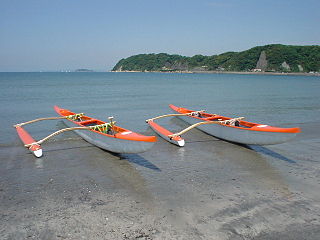
Outrigger boats are various watercraft featuring one or more lateral support floats known as outriggers, which are fastened to one or both sides of the main hull. They can range from small dugout canoes to large plank-built vessels. Outrigger boats can also vary in their configuration, from the ancestral double-hull configuration (catamarans), to single-outrigger vessels prevalent in the Pacific Islands and Madagascar, to the double-outrigger vessels (trimarans) prevalent in Island Southeast Asia. They are traditionally fitted with Austronesian sails, like the crab claw sails and tanja sails, but in modern times are often fitted with petrol engines.

The Iranun are an Austronesian ethnic group native to southwestern Mindanao, Philippines. They are ethnically and culturally closely related to the Maranao, and Maguindanaon, all three groups being denoted as speaking Danao languages and giving name to the island of Mindanao. The Iranun were traditionally sailors and were renowned for their ship-building skills. Iranun communities can also be found in Malaysia and Philippines.

A galley slave was a slave rowing in a galley, either a convicted criminal sentenced to work at the oar, or a kind of human chattel, sometimes a prisoner of war, assigned to the duty of rowing.

Banguingui, also known as Sama Banguingui or Samal Banguingui is a distinct ethnolinguistic group native to Balanguingui Island but also dispersed throughout the Greater Sulu Archipelago and southern and western coastal regions of the Zamboanga Peninsula in Mindanao, Philippines. They are one of the ethnic groups usually collectively known as the Sama-Bajau peoples.

The vinta is a traditional outrigger boat from the Philippine island of Mindanao. The boats are made by Sama-Bajau, Tausug and Yakan peoples living in the Sulu Archipelago, Zamboanga peninsula, and southern Mindanao. Vinta are characterized by their colorful rectangular lug sails (bukay) and bifurcated prows and sterns, which resemble the gaping mouth of a crocodile. Vinta are used as fishing vessels, cargo ships, and houseboats. Smaller undecorated versions of the vinta used for fishing are known as tondaan.
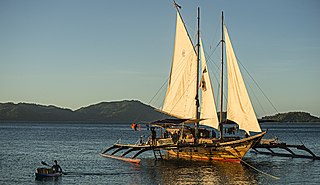
A balangay, or barangay, is a type of lashed-lug boat built by joining planks edge-to-edge using pins, dowels, and fiber lashings. They are found throughout the Philippines and were used largely as trading ships up until the colonial era. The oldest known balangay are the Butuan boats, which have been carbon-dated to 320 AD and were recovered from several sites in Butuan, Agusan del Norte.
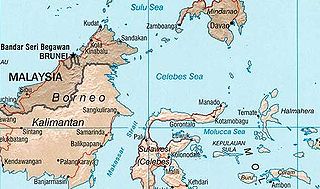
The Sulu and Celebes Seas, a semi-enclosed sea area and porous region that covers an area of space around 1 million square kilometres, have been subject to illegal maritime activities since the pre-colonial era and continue to pose a maritime security threat to bordering nations up to this day. While piracy has long been identified as an ubiquitous challenge, being historically interwoven with the region, recent incidents also include other types of maritime crimes such as kidnapping and the trafficking of humans, arms and drugs. Attacks mostly classify as 'armed robbery against ships' according to the United Nations Convention on the Law of the Sea as they occur in maritime zones that lie under the sovereignty of a coastal state. Incidents in the Sulu and Celebes Seas specifically involve the abduction of crew members. Since March 2016, the Information Sharing Centre (ISC) of the Regional Cooperation Agreement on Combating Piracy and Armed Robbery against Ships in Asia (ReCAAP) reports a total of 86 abductions, leading to the issue of a warning for ships transpassing the area.
Spanish slavery was introduced to the Philippines through the encomienda system which was instituted throughout the Indies by Nicolás de Ovando, governor of the Indies from 1502 to 1509. This system rewarded Spanish conquerors with forced labor from the native peoples. A system of serfdom, the pre-colonial alipin system, already existed before the islands were colonized by the Spanish Empire in 1565, but it differed in that groups of native people were not obliged to render forced labor to superiors. Rather, the alipin rendered services and labor under a complex system of obligations; indeed the etymology indicates that they were originally war captives rendering ransom. After a Spanish clergyman and social reformer Bartolomé de las Casas wrote about the abuses of the encomienda system and of the native peoples in his book A Short Account of the Destruction of the Indies, public outcry and his lobbying in Spain caused the enaction of the New Laws in 1542. According to his firsthand accounts, enslaved natives in the Indies were burned alive, starved, forced to work in mines, and the women stopped producing milk because of the hard labor they were forced into.' While no similarly graphic accounts exists of the abuses endured by the native Filipinos, several revolts occurred due to encomienda even after the passage of the new laws and continued abuse of the system was recorded.

Karakoa were large outrigger warships from the Philippines. They were used by native Filipinos, notably the Kapampangans and the Visayans, during seasonal sea raids. Karakoa were distinct from other traditional Philippine sailing vessels in that they were equipped with platforms for transporting warriors and for fighting at sea. During peacetime, they were also used as trading ships. Large karakoa, which could carry hundreds of rowers and warriors, were known as joangas by the Spanish.

Lanong were large outrigger warships used by the Iranun and the Banguingui people of the Philippines. They could reach up to 30 m (98 ft) in length and had two biped shear masts which doubled as boarding ladders. They also had one to three banks of oars rowed by galley slaves. They were specialized for naval battles. They were prominently used for piracy and slave raids from the mid-18th century to the early 19th century in most of Southeast Asia. The name lanong is derived from Lanun, an exonym of the Iranun people.

Garay were traditional native warships of the Banguingui people in the Philippines. In the 18th and 19th centuries, they were commonly used for piracy by the Banguingui and Iranun people against unarmed trading ships and raids on coastal settlements in the regions surrounding the Sulu Sea.
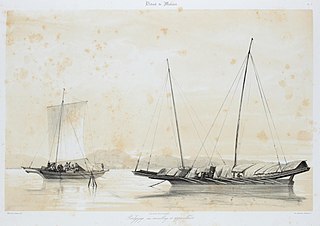
Penjajap, also pangajava and pangayaw, were native galley-like warships used by several Austronesian ethnic groups in maritime Southeast Asia. They were typically very long and narrow, and were very fast. They are mentioned as being used by native fleets in Indonesia, the southern Philippines, Malaysia, and Brunei.

Buggoh is a type of small dugout canoe of the Sama-Bajau people of the Philippines. They are made from a single log hollowed into a canoe with a rounded bottom. It is equal-ended, with the prow and the stern dropping straight down or sloping outward. They are sometimes equipped with two outrigger floats. They are usually around 1.5 to 4.5 m long. It is also known by various other names, including boggo', buggoh jungalan, buggoh-buggoh, or beggong.

Bangka are various native watercraft of the Philippines. It originally referred to small double-outrigger dugout canoes used in rivers and shallow coastal waters, but since the 18th century, it has expanded to include larger lashed-lug ships, with or without outriggers. Though the term used is the same throughout the Philippines, "bangka" can refer to a very diverse range of boats specific to different regions. Bangka was also spelled as banca, panca, or panga in Spanish. It is also known archaically as sakayan.
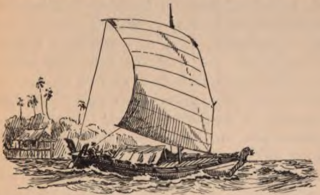
A kakap is a narrow river or coastal boat used for fishing in Malaysia, Indonesia, and Brunei. They are also sometimes used as auxiliary vessels to larger warships for piracy and coastal raids.
Bangka anak-anak are very small dugout canoes among the Sama-Bajau people of the Philippines. They are typically made by Sama-Bajau fathers for their children and are patterned after the larger Sama-Bajau dugout canoes. They can be used for transportation between the Sama-Bajau houseboats, but are more commonly used for playing. They are typically no longer than around 1.5 m (4.9 ft) long. Children as young as three or four can use these boats, which allows them to learn valuable maritime skills.

Bangkong is the war boat of dayak people, notably used by sea dayaks of Indonesia, Malaysia and Brunei. They are used for riverine warfare in Borneo, but they are also capable of sailing across the sea.

A juanga or joanga refers to large-sized kora-kora, karakoa and lanong. They are used all throughout the Philippines and Eastern Indonesia, in Maluku smaller versions were popular and are still used to this day (Kora-kora). They are propelled by oars but are not used for carrying cargo.

Austronesian vessels are the traditional seafaring vessels of the Austronesian peoples of Taiwan, Maritime Southeast Asia, Micronesia, coastal New Guinea, Island Melanesia, Polynesia, and Madagascar. They also include indigenous ethnic minorities in Vietnam, Cambodia, Myanmar, Thailand, Hainan, the Comoros, and the Torres Strait Islands.






















